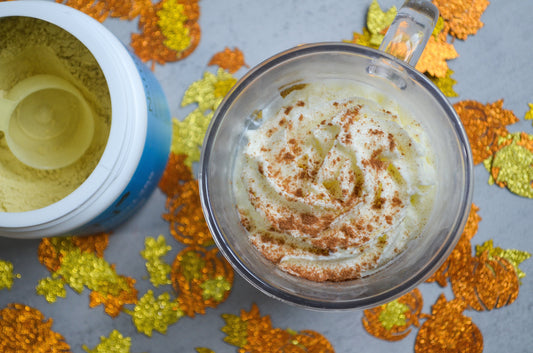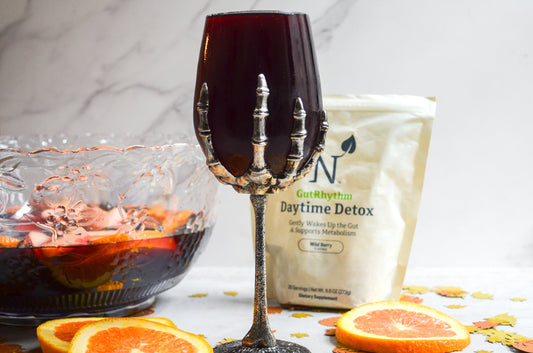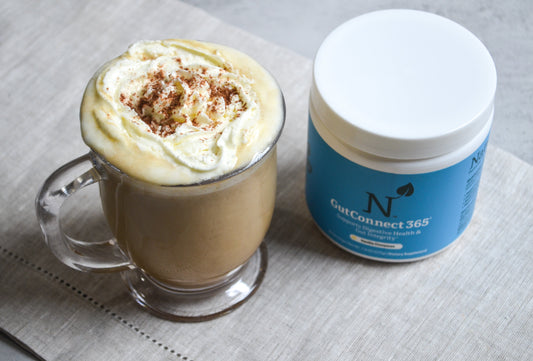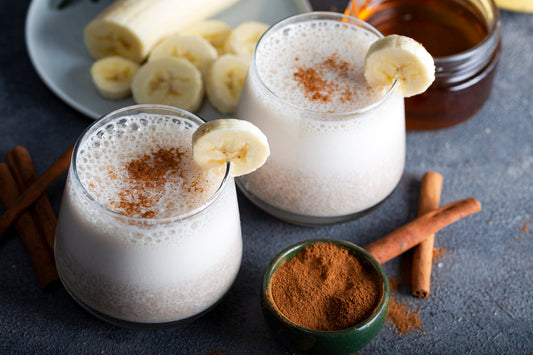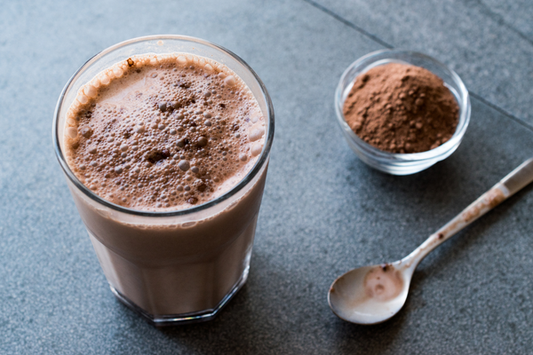Did you know that almost 70% of your immune system is housed in the digestive tract? Or that the state of your digestive tract can affect your mental health? Or that the process of digestion is responsible for giving our bodies the essential nutrients we need for growth, energy, and repair?
Digestion is so much more than just food entering and exiting our body. So, let’s break down what the digestive process really looks like — from beginning to end.
How Our Digestive System Works
Every organ in the digestive system plays its own unique role:
- The mouth chews food and begins the breakdown of carbohydrates and lipids via enzymes in your saliva.
- The pharynx then pushes food from the oral cavity to the esophagus, where food is lubricated and propelled to the stomach.
- The stomach mixes and churns food to produce chyme; the chemical breakdown of protein begins; and there is absorption of some fat-soluble substances.
- The small intestine mixes chyme with digestive juices for optimal digestion. It then absorbs carbohydrates, lipids, proteins, and nucleic acids along with vitamins, minerals, and water.
- The liver, gallbladder, and pancreas are accessory organs that function in producing bile to emulsify lipids for better digestion and absorption, storage and release of bile, and the production of digestive enzymes and bicarbonate.
- The large intestine further breaks down food residues, and absorbs residual water, electrolytes, and vitamins produced by gut bacteria. The large intestine then propels the waste through the rectum to exit the body.
Bacteria in the GI tract, also called gut flora, are essential to digestion and impact the function of various systems within the body. Parts of the nervous and circulatory systems also play roles in the digestive process. Together, a combination of nerves, hormones, bacteria, blood, and the organs of the digestive system complete the task of digesting the foods and liquids you consume each day.
Digestion and Nutrient Absorption
As you can see, this system is complex. With a lot of moving parts and processes, it is imperative that we can understand if our digestive system is operating correctly and efficiently. In order to have great digestion, you need a strong and healthy gut lining as well as a diverse gut flora. Why is this important? These two characteristics determine the nutrient absorption that occurs.
Optimal nutrient absorption is necessary for stronger bones, agile muscles, lubricated joints, clear skin, a stabilized mood, and a healthy immune system that can defend against invasive pathogens. However, if digestion is hindered and nutrients are not absorbed correctly, it can lead to a build-up of toxins and nutritional deficiencies. The whole body will start to suffer as a consequence. We will become more prone to unpleasant digestive symptoms like diarrhea or constipation, an immune system that is more vulnerable to infection, bones that are more brittle, moods more irritable, and feelings of being tired, less energetic, and generally unwell.
Connection Between Digestion and Optimal Health
Because there are many external and internal factors that can influence our digestive system, it is unfortunately not uncommon to have poor digestion and, as a result, poor health. Each year, 62 million Americans are diagnosed with a digestive disorder. The incidence and prevalence of most digestive diseases increase with age. Some of the symptoms that show your digestive system needs extra support are abdominal pain, bloating, loose stools, constipation, heartburn, nausea, or vomiting.
While those are more obviously connected to our digestion, there are many other signs we can look out for that indicate the health of our gut, such as:
- Autoimmune diseases
- Frequent food sensitivities
- Inflammatory skin conditions
- Compromised immunity
- Joint pain
- Sleep disturbances
- Fatigue
- Poor mood
Digestion and Gut Health
In order to understand how the body can get to a state of poor digestive health, it’s important to understand the structure and nature of the gut lining and gut flora. The lining of your intestine is made of millions and millions of cells. These cells join together to create a tight barrier that acts like a security system and decides what gets absorbed into the bloodstream and what stays out.
In an unhealthy gut, the lining can weaken, so “holes” develop in the barrier. The result is that toxins and bacteria can leak into the body. This can trigger a chain reaction of problems in the gut and throughout the body.
How do these holes form? The biggest culprits are genes and diet. Some people may have a weaker barrier because they were born with it, or they follow an unbalanced diet low in fiber and high in sugar and saturated fats. This way of eating has been widely accepted in scientific literature as a strong trigger that weakens the gut lining and reduces beneficial gut bacteria. Age also plays a role because as you age, cells get damaged more easily and heal slowly, if at all, so the gut becomes more vulnerable. Additionally, as you age, your bacterial population diminishes and the populations of bacteria growing are less diverse.
The gut flora contains healthy and unhealthy gut bacteria, and maintaining a proper balance is crucial. Living inside of your gut are hundreds of different kinds of bacteria containing millions of different genes. The mix of bacteria in your body is different from everyone else’s mix. They line your entire digestive system and can affect everything from your metabolism to your mood to your immune system. Research suggests the gut bacteria in healthy people are different from those with certain diseases. People who are sick may have too little or too much of a certain type. Or they may lack a wide variety of bacteria. It’s thought some kinds may protect against ailments, while others may raise the risk.
Does Our Digestion Slow as We Age?
There are some changes in aging that people talk openly about, like wrinkles and hot flashes; however, digestion is also subject to age related changes. Aging can affect digestion in a multitude of ways. For example, starting in your 60s, some digestive enzymes and beneficial gut bacteria decrease. A decrease makes it more difficult for the body to digest food, and can cause an imbalance in the gut which can manifest in many ways such as diarrhea, constipation, heartburn, and leaky gut. Some of the main culprits that affect older populations’ digestion have more to do with lifestyle choices rather than what happens internally during the natural aging process. Be aware of medications that can cause gastrointestinal issues, dehydration, and inactivity/sedentary lifestyle. Making small changes to combat these specific issues can drastically change digestion. Most importantly, consuming a diet and living a lifestyle to promote copious amounts of beneficial gut bacteria is key to preventing leaky gut and supporting the aging digestive system. Lastly, you can increase digestive enzymes by taking them in supplement form or triggering production through digestive bitters or apple cider vinegar before a meal.
How to Support Healthy Digestion
While we can’t necessarily control our genes, we can control our diet and lifestyle choices. The right choices can create better balance in your gut flora and increase the integrity of your gut lining to truly heal, energize, and help the body absorb maximum amounts of nutrients for optimal health.
There are a few major ways we can improve and maintain digestive health. Your digestive system needs the proper balance of bacteria and enzymes to further break down food. Probiotic foods like sauerkraut and yogurt coupled with prebiotic foods such as legumes and artichokes with additional fruits and vegetables will provide these essentials to your digestive system. Your digestive system also requires an adequate amount of fiber (25g for women and 38g for men) to move food through your digestive system and absorb water. A diet that promotes digestive health should focus on fibrous vegetables and fruits as these foods contain phytochemicals which have been reported to improve tight junction integrity by controlling proteins and inflammatory signaling pathways.
While raw vegetables and fruits may be difficult to digest, cooked or blended vegetables are just as powerful in healing and supporting the body. Choose a wide variety of colorful vegetables and fruits with plenty of leafy greens. Healthy fats are another great option to support gut healing. Omega-3 fatty acids and medium-chain-triglycerides (MCT) are known to diversify the microbiome and increase intestinal integrity. Supplements containing L-glutamine can also transform digestion. L-glutamine is a key amino acid that supports the growth and repair of intestinal cells as well as soothes and coats the gut to protect against further irritation.
Additional Ways to Improve Digestion and Gut Health
Beyond diet, getting adequate sleep, managing stress levels, and engaging in exercise are all science-backed ways to ensure your gut and digestive system are functioning properly. By making choices to prioritize your health, you can change the way you look and feel from the inside out. Some other tips to better digestion include:
- Chewing food slowly and thoroughly: Chewing a bite of food roughly 20 times allows that food to properly begin the digestive process, and it will have an easier time moving through your system.
- Be fully present at mealtimes: Adopting practices that allow one to be more present at meal times can give you a better sense of how the food is making you feel, and lends itself to smoother digestion and high nutrient absorption. The best way to get started being present at mealtimes is to relax before you begin eating. Make sure to avoid tea or coffee close to meal times as they can interfere with the absorption of nutrients like iron and hormones like levothyroxine. Eating under high stress, on the go, or too quickly can also hinder digestion and absorption of key nutrients.
- Pair your foods wisely: How you combine your foods can play a major role in the absorption of nutrients. Pairing foods wisely can increase nutrient absorption and also promote overall health. Include protein-rich foods in every meal to get maximum benefits from healthy food pairings.
- Eat your enzymes: Make sure your diet includes enzyme supplements or enzyme-rich foods like sauerkraut, mango, raw honey, papaya and avocado. Raw honey, for instance, contains diastase (amylase), esterase, catalase, glucose oxidase, invertase and other enzymes that support digestion. Mango is high in amylase, an enzyme that breaks down carbs from starch. Papain, an enzyme in papaya, helps your body digest protein. Avocado is naturally rich in lipase, the enzyme responsible for breaking down lipids. Adding these in during mealtime can allow for more efficient digestion.
- Choose your cooking methods wisely: Beware that cooking destroys food enzymes. Steaming, sprouting, soaking, blending and juicing, on the other hand, allow you to preserve the enzymes and antioxidants in food. However, certain vegetables become more nutritious after being cooked. To stay healthy, try to strike a balance between raw and cooked foods.
I hope I’ve shed a little more light on the intricacies of your digestive system, and offered some simple ways you can start making real changes for a healthier lifestyle. Just one little change can make a whole world of difference!
Here’s to your health and happiness!
Your Nature M.D. Wellness Team



